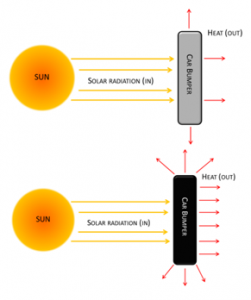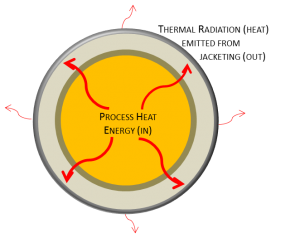Emissivity will influence process control and personnel safety. Industrial processes have higher operating temperatures than residential, commercial and mechanical processes, and that creates unique challenges for designers. Among these challenges is the impact that metal jacketing has on the surface temperature of the insulated pipe system. When designers specify metal jacketing around the insulation, they need to account for a significant increase in the surface temperature of the insulated pipe system in order to ensure that process control is optimized and personnel safety is maintained. How is it possible that metal jacketing can affect a system so significantly that two identical systems, one jacketed with shiny metal (industrial) and one jacketed with a dull finish (commercial or mechanical), can have dramatically different surface temperatures? The difference is caused by the emissivity of the jacketing.
When we measure a material’s emissivity, we are measuring its ability to radiate heat that has been transferred into the material (e.g., metal radiating heat it has absorbed from the sun). Emissivity is the ratio of heat energy emitted (radiated) from a given material to the heat energy emitted from a “perfect heat energy emitter” (something that immediately radiates 100% of the heat that it absorbs). Most materials have an emissivity value (ɛ) that ranges between 0.02 and 0.95. The higher the (ɛ) value, the more heat energy will be emitted in a given period of time, thus a “perfect heat energy emitter” would have an emissivity value of 1. What this translates to in layman’s terms is that materials with lower emissivity will allow less heat to pass through, ultimately retaining it, and as a result, they will get hotter than materials with a higher emissivity value. For example, if you were to compare the temperatures of a black bumper on a car ((ɛ) = .95) and a chrome bumper on a car ((ɛ) = .04) on a hot, summer day you would find that the black bumper is cooler than the chrome bumper because it has a higher emissivity value.
 Since the chrome bumper has a lower emissivity, it releases (radiates) the heat it absorbs from the sun more slowly, causing the heat to build and the temperature to rise within the bumper. Meanwhile the black bumper with the higher emissivity radiates the heat more quickly, allowing it to leave the material before the temperature can increase to the same extent as the chrome bumper. Even though the example above uses an external heat source (the sun), emissivity is also at play when the heat source is internal - such as a hot, insulated pipe that is wrapped in metal jacketing. In an industrial setting with above-ambient temperature processes, we have to account for the heat energy that transfers from inside the pipe, through the insulation, and into
Since the chrome bumper has a lower emissivity, it releases (radiates) the heat it absorbs from the sun more slowly, causing the heat to build and the temperature to rise within the bumper. Meanwhile the black bumper with the higher emissivity radiates the heat more quickly, allowing it to leave the material before the temperature can increase to the same extent as the chrome bumper. Even though the example above uses an external heat source (the sun), emissivity is also at play when the heat source is internal - such as a hot, insulated pipe that is wrapped in metal jacketing. In an industrial setting with above-ambient temperature processes, we have to account for the heat energy that transfers from inside the pipe, through the insulation, and into

the jacketing, where the heat energy is then emitted from the surface of the jacketing. High emissivity jacketing will allow heat to escape more quickly from the system, which results in lower surface temperatures. In contrast, a jacketing with a low (ɛ) value will reduce overall heat loss, but it will increase the surface temperature because the material is actually storing the heat The chart below compares the surface temperatures between high emissivity jacketing and low emissivity jacketing in identical applications that are designed to achieve safe-to-touch temperatures.

As we look at this chart, one question becomes clear - if jacketing with a higher emissivity is able to result in a lower surface temperature, why does the industrial market overwhelmingly use low emissivity metal jacketing? The simple answer is threefold: usability, cost, and heat-retention. Aluminum metal jacketing addresses the first two factors easily. In-service aluminum cladding that is 0.016”- 0.020” thick is easy to install, and it is the lowest cost cladding that can be used in outdoor applications. Other lower-cost claddings, such as ASJ, are often used indoors for commercial projects, but these are not an appropriate outboard cladding for piping that is exposed to outdoor weather. When we consider the third factor, heat retention, we need to take a deeper look at the jacketing’s emissivity. The chart below details how the emissivity of the jacketing can affect the heat loss of the overall system.

While the higher emissivity cladding reduces the amount of insulation needed to maintain the 140°F surface temperature requirement, the heat loss is significantly higher than that of the aluminum jacketing system. As a result, the amount of insulation necessary to minimize heat loss and ensure optimized process control with a high-emissivity jacketing is roughly the same as the amount of insulation required to maintain safe-to-touch surface temperatures on a system with a low-emissivity jacketing. Since the two top priorities for industrial insulation systems are process control and maintaining safe-to-touch surface temperatures, accounting for the emissivity of the jacketing in system design is critical. In order to ensure that both goals are successfully achieved, selecting a cladding that can work in tandem with the insulation to both retain heat-energy and ensure safe surface temperatures is essential.
